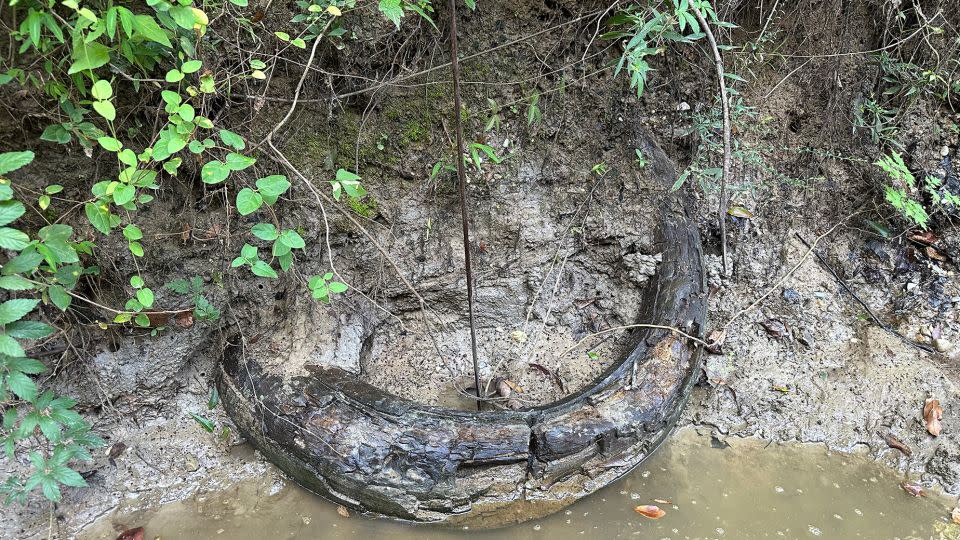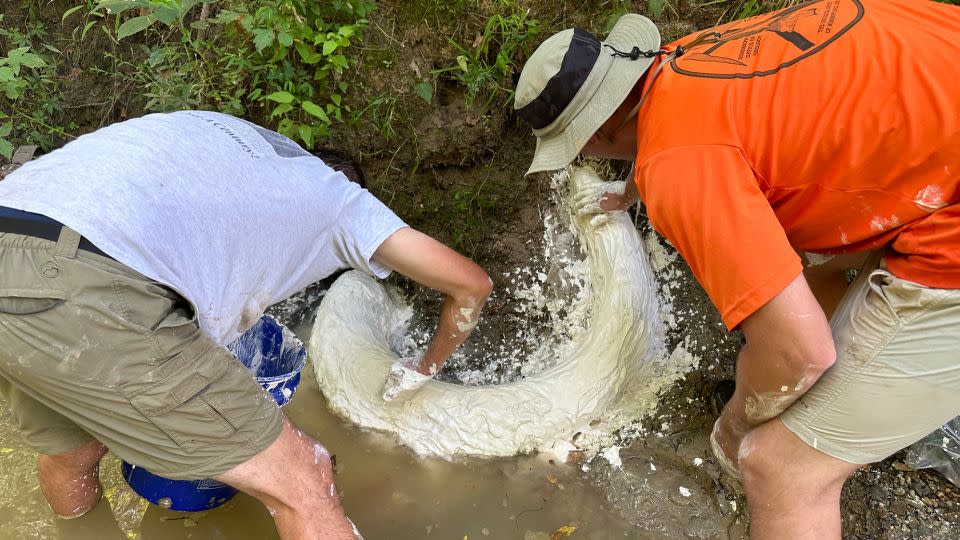Sign up for CNN’s Wonder Theory science newsletter. Explore the universe with news on fascinating discoveries, scientific advancements and more.
Amateur fossil hunter Eddie Templeton usually knows when he’s onto something. Having scoured creek banks in Mississippi since he was a kid, Templeton has made several stunning extinct mammal finds, including a mastodon mandible, numerous bones from a giant armadillo-relative, and even a saber-toothed cat’s foot bone. But his latest discovery may be the most unexpected.
Templeton was wading through around 3 feet (almost 1 meter) of water in a creek in Madison County on August 3 when he stumbled across a giant tusk partially exposed from the mud bank. The conditions weren’t great for fossil hunting, he said — the water had been blocked from draining downstream and there were no exposed gravel bars — so he hadn’t anticipated making a find of any particular importance that day. Coming across the 7-foot-long (2.1-meter-long) tusk, which turned out to be completely intact, and sharing it with George Phillips, the curator of paleontology at the Mississippi Museum of Natural Science, proved him wrong.
Phillips confirmed the tusk belonged to a Columbian mammoth, a distant relative of the woolly mammoth. Columbian mammoths lived during the end of the Pleistocene Epoch, making the fossil anywhere from about 11,700 to 75,000 years old, Phillips said.


“It was exciting to find a big piece of a tusk, certainly. But it was particularly exciting that it was a mammoth,” Templeton told CNN. “After the geologists got there, and we started uncovering it and realized that it was the entire tusk, from tip to base, it was even more exciting. So things just got better as the day went on.”
Prior to Templeton’s discovery, only isolated teeth of the Columbian mammoth had been unearthed in Mississippi, making it a first-of-its-kind find for the region and offering a “rare window” into the giant ice age mammals that once roamed the area, according to a statement from the Mississippi Department of Environmental Quality.
Discovering Mississippi mammoths
While the massive Columbian mammoth — which weighed over 22,000 pounds (10 tons) and could grow to be over 13 feet (4 meters) tall — lived across North America alongside the mastodon, its diet largely consisted of grasses found in grassland biomes, which were rare on what’s now the East Coast of the United States during that period, Phillips said. As a result, its fossils are much harder to come by in the area.
“For every, say, 25 fragments or whole teeth of American mastodon, we find maybe one mammoth tooth at best. So, mammoths are proportionally rare, not just with respect to mastodons, but to everything else,” Phillips said.
When Templeton first came across the giant tusk, he assumed it was from a mastodon, having found several remnants of the creature on his prior hunts. It was after the local museum and state office of geology helped him unearth the massive remains that Templeton began to have second thoughts — mostly due to the fossil’s telltale curve.
The Columbian mammoth’s tusks are so curved that two could almost make a complete circle, whereas common mastodons’ tusks do not curve nearly as much, Phillips said. The museum has numerous tooth fragments and even several complete teeth from the mammoth — there may even be some fragments of tusks from the giant mammal that cannot be distinguished from the mastodon without having the rest of the tusk — but a complete, intact tusk like the one discovered is especially rare, he added.
“I was kind of open mouthed when I saw the picture,” Phillips said. “I thought, ‘OK, well, cool, a tusk. Wait a second … it’s so curved. Holy cow, this is a mammoth tusk.’”
While unearthing the fossil, the field scientists simultaneously covered the exposed bits with plaster to keep the fossil protected during extraction. The tusks grew in rings, similar to how trees grow, Templeton said, which causes the fossils to be more likely to fragment once they dry up after being taken from the moist deposits where they are found.


The tusk — which weighed 600 pounds (272 kilograms) with the plaster jacket — is currently at the museum, where experts will closely monitor it while it dries out and then treat it with a cohesive for preservation. Scientists will also need to reassemble the fragile fossil, which broke into two pieces during transportation. Phillips said he hopes to have the tusk on display in time for the museum’s annual Fossil Road Show during the first week of March next year.
“I think most people are curious about the past, and these megafauna that existed during the ice age fascinate people,” Templeton said. “I’m sure there have been pieces of mammoth tusk found in Mississippi, but probably not positively identified as mammoths just because they’re fragments. But this is the first complete mammoth tusk found in Mississippi. And so that’s pretty cool.”
For more CNN news and newsletters create an account at CNN.com
